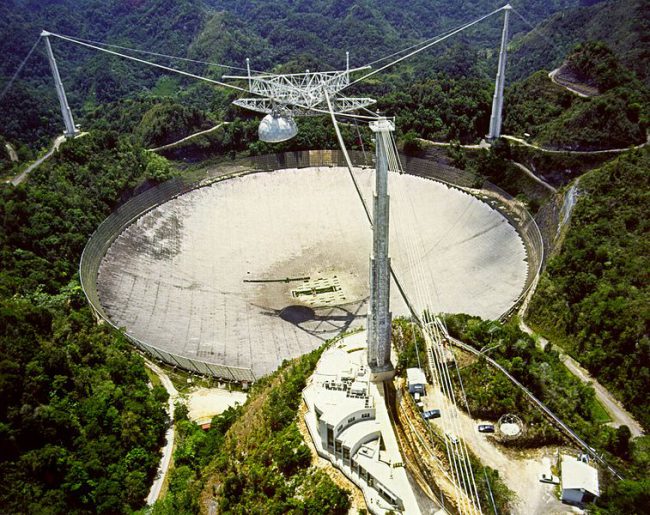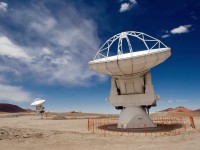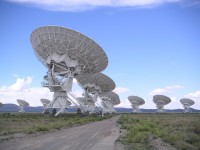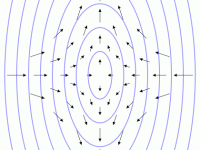
Aerial view of Arecibo Observatory in December 2012, photo: H. Schweiker/WIYN and NOAO/AURA/NSF, CC BY 4.0, via Wikimedia Commons
On November 1, 1963, the Arecibo radio telescope, by that time the earth‘s largest radio telescope, has been inaugurated in Arecibo, Puerto Rico. It is operated by the company SRI International under cooperative agreement with the National Science Foundation and is also called the National Astronomy and Ionosphere Center, although “NAIC” refers to both the observatory and the staff that operates it.
Construction and Functionality
The Arecibo telescope was built between the summer of 1960 and November 1963, and was originally intended to be used to study Earth’s ionosphere. As the primary dish is spherical, its focus is along a line rather than at a single point (as would be the case for a parabolic reflector); therefore, complicated line feeds had to be used to carry out observations. Until the present day, the telescope has been upgraded several times. The main collecting dish is 305 m in diameter, constructed inside the depression left by a karst sinkhole. It contains the largest curved focusing dish on Earth, giving Arecibo the largest electromagnetic-wave-gathering capacity. The dish surface is made of 38,778 perforated aluminum panels, each measuring about 1 by 2 m, supported by a mesh of steel cables. The telescope has three radar transmitters, with effective isotropic radiated powers of 20 TW at 2380 MHz, 2.5 TW (pulse peak) at 430 MHz, and 300 MW at 47 MHz. The telescope itself is a spherical reflector, not a parabolic reflector. To aim the telescope, the receiver is moved to intercept signals reflected from different directions by the spherical dish surface. A parabolic mirror would induce a varying astigmatism when the receiver is in different positions off the focal point, but the error of a spherical mirror is the same in every direction.

A wide panorama of the Arecibo radio telescope made from the observation deck, photo: Evilkalla at English Wikipedia, CC BY-SA 3.0, via Wikimedia Commons
The receiver of the telescope is located on a 900-ton platform which is suspended 150 m in the air above the dish by 18 cables running from three reinforced concrete towers, one of which is 110 m high and the other two of which are 80 m high. The platform has a 93-meter-long rotating bow-shaped track called the azimuth arm on which receiving antennas, secondary and tertiary reflectors are mounted. This allows the telescope to observe any region of the sky within a forty-degree cone of visibility about the local zenith. Puerto Rico’s location near the equator allows Arecibo to view all of the planets in the Solar System, though the round trip light time to objects beyond Saturn is longer than the time the telescope can track it, preventing radar observations of more distant objects.
Discoveries in Arecibo
Many significant scientific discoveries have been made using the Arecibo telescope. On April 7, 1964, shortly after it began operations, the rotation rate of Mercury could be determined to be only 59 days instead of the until then believed 88 days. In 1968, the discovery of the periodicity of the Crab Pulsar (33 milliseconds) provided the first solid evidence that neutron stars exist. In 1974, Russel Hulse and Joseph Taylor discovered the first binary pulsar PSR B1913+16, an accomplishment for which they later received the Nobel Prize in Physics. In 1982, the first millisecond pulsar, PSR B1937+21, was discovered, which spins 642 times per second, and until the discovery of PSR J1748-2446ad in 2005, it was the fastest-spinning pulsar known. In 1974, the so-called Arecibo message, an attempt to communicate with potential extraterrestrial life, was transmitted from the radio telescope toward the globular cluster M13, about 25,000 light-years away. It contained a binary pattern of 1,679 bit that defined a 23 by 73 pixel bitmap image that included numbers, stick figures, chemical formulas, and a crude image of the telescope itself. The cardinality of 1679 was chosen because it is a semiprime (the product of two prime numbers). The Arecibo message was broadcast into space a single time via frequency modulated radio waves at a ceremony to mark the remodeling of the Arecibo radio telescope on 16 November 1974.
Destruction
Since 2006, the NSF has reduced its funding commitment to the observatory, leading academics to push for additional funding support to continue its programs. The telescope was damaged by Hurricane Maria in 2017 and was affected by earthquakes in 2019 and 2020. Two cable breaks, one in August 2020 and a second in November 2020, threatened the structural integrity of the support structure for the suspended platform and damaged the dish. Due to uncertainty over the remaining strength of the other cables supporting the suspended structure, and the risk of collapse owing to further failures making repairs dangerous, the NSF announced on November 19, 2020, that the telescope would be decommissioned and dismantled, with the radio telescope and LIDAR facility remaining operational. Before it could be decommissioned, several of the remaining support cables suffered a critical failure and the support structure, antenna, and dome assembly all fell into the dish at 7:55 a.m. local time on December 1, 2020, destroying the telescope.
Bill Diamond, Michael Bush, Tour the Arecibo Telescope [11]
Further Reading and References:
- [1] How the Arecibo Telescope works, Cornell University
- [2] The Arecibo Observatory Homepage
- [3] The Arecibo Observatory at Wikidata
- [4] The Sputnik Shock
- [5] SpaceShipOne – The first private Spaceship , SciHi Blog
- [6] James van Allen and the Weather in Space, SciHi Blog
- [7] The First Image from Abroad – Earth Rising and Lunar Orbiter 1, SciHi Blog
- [8] Fred Hoyle and the Big Bang Theory, SciHi Blog
- [9] Shoemaker-Levy 9 hits Jupiter, SciHi Blog
- [10] The Supernova of 1054, SciHi Blog
- [11] Bill Diamond, Michael Bush, Tour the Arecibo Telescope, SETI Institute @ youtube
- [12] Radio telescopes around the world, via Wikidata






Pingback: Whewell’s Gazette: Year 2, Vol. #17 | Whewell's Ghost